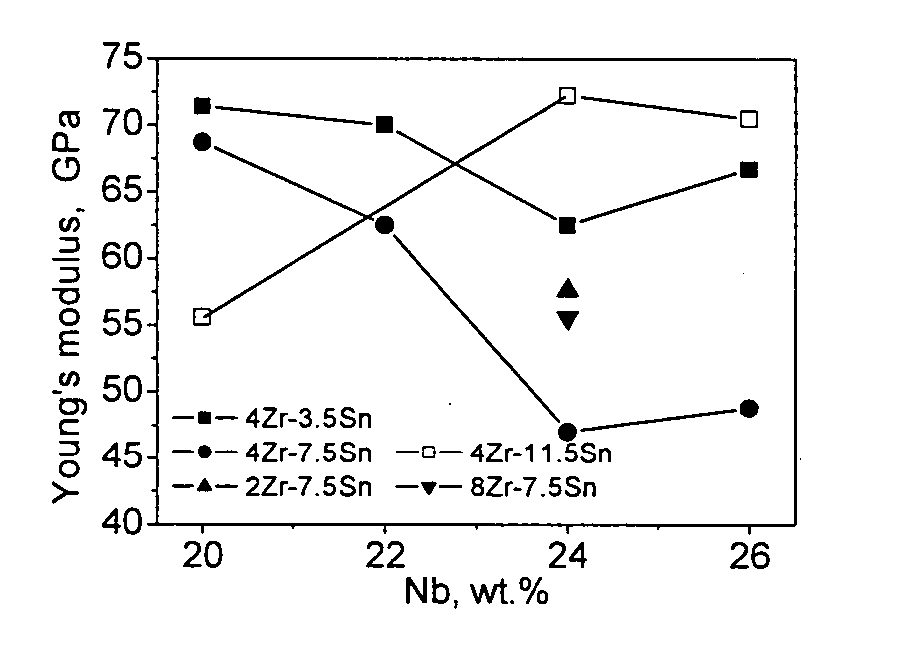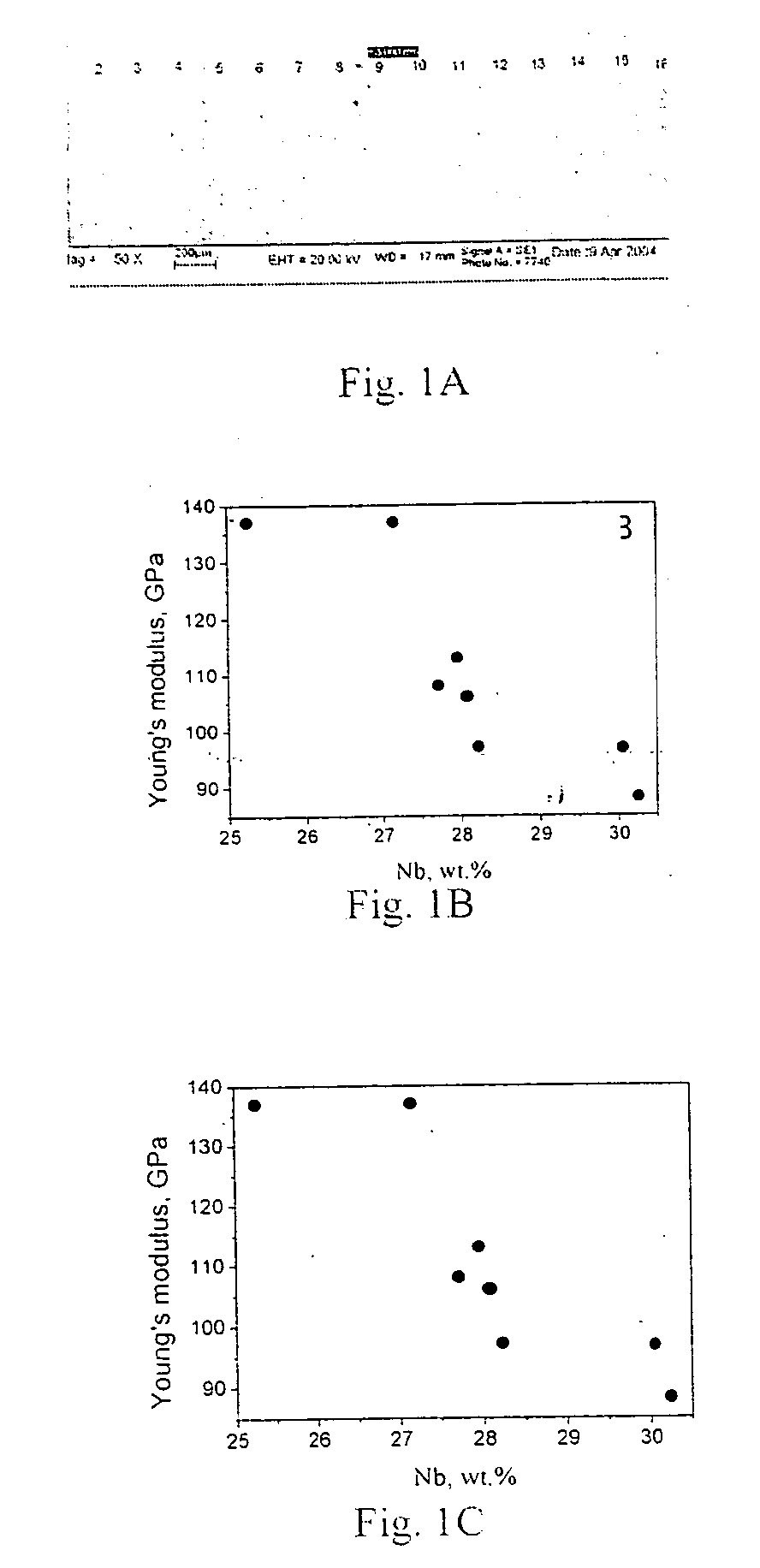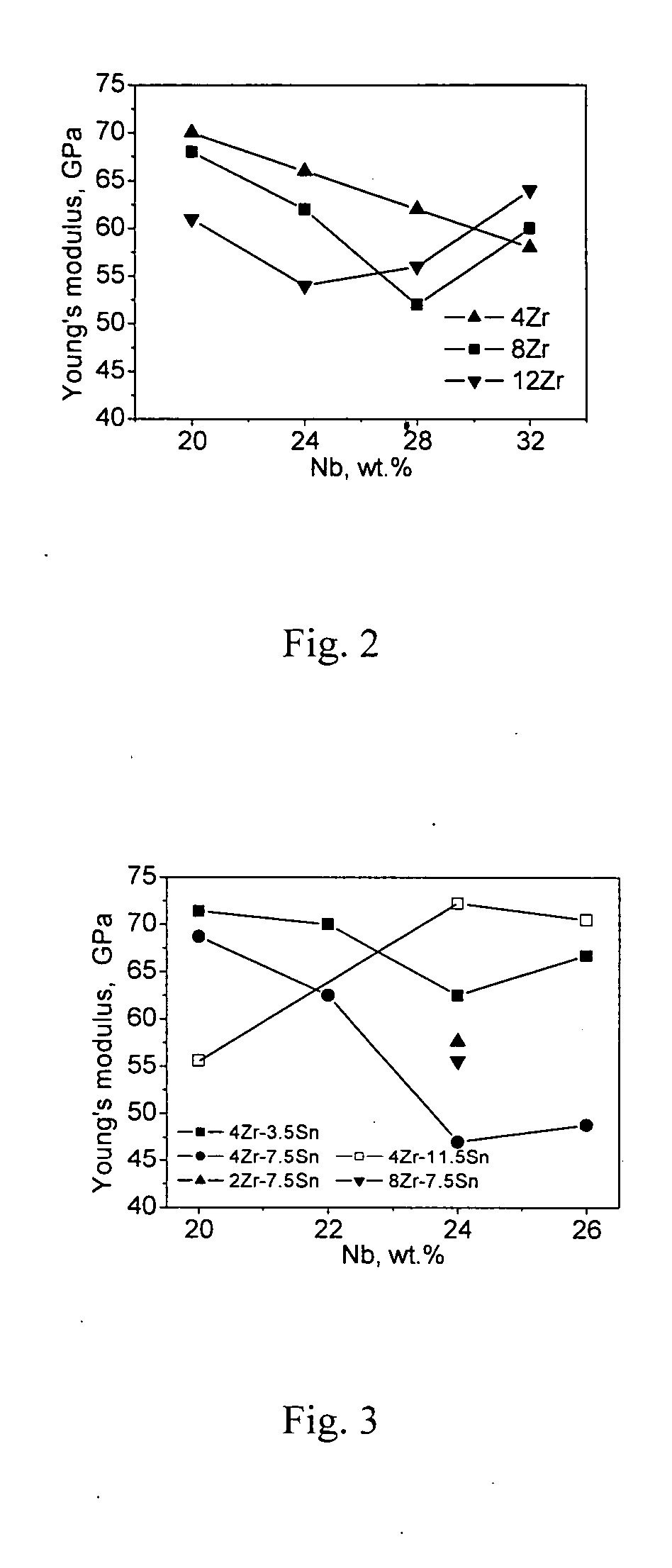Titanium alloy with extra-low modulus and superelasticity and its producing method and processing thereof
- Summary
- Abstract
- Description
- Claims
- Application Information
AI Technical Summary
Benefits of technology
Problems solved by technology
Method used
Image
Examples
example 1
[0048] The master alloys listed in Table 1 were melted with a non-consumable arc melting furnace with magnetic agitation. To ensure chemical homogeneity, the buttons with weight of 60 g were melted three times. They were forged at 950° C. to bars with cross-section of 10 mm×10 mm and specimens with dimension of 20×6×4 mm were cut. After grinding and polishing, they were diffusion-coupled at 1000° C. for 4 h in. vacuum according to chemical composition listed in Table 1. These couples were heat-treated at 1300° C. for 50 h to obtain diffusion coupled with thickness of more than 1 mm. FIGS. 1A and 1B shown SEM photograph and EDS analysis results of Ti-20Nb-5Zr / Ti-35Nb-5Zr diffusion couple.
TABLE 1Chemical composition of Ti—Nb—Zr / Ti—Nb—Zr andTi—Nb—Zr—Sn / Ti—Nb—Zr—Sn diffusion couples (wt. %).Ti-20Nb-2Zr / Ti-35Nb-2ZrTi-20Nb-5Zr / Ti-35Nb-5ZrTi-20Nb-8Zr / Ti-35Nb-8ZrTi-20Nb-4Zr -2Sn / Ti-20Nb-4Zr -5Sn / Ti-20Nb-4Zr-8Sn / Ti-35Nb-4Zr -2SnTi-35Nb-4Zr -5SnTi-35Nb-4Zr -8SnTi-20Nb-8Zr -2Sn / Ti-20Nb-8Zr -...
example 2
[0051] Differences from Example 1 are as follows. This example is to investigate the effect of alloying on α″ martensite starting transformation temperature and to identify chemical composition range that exhibits high recoverable strain.
[0052] The alloys were melted three times with a non-consumable arc melting furnace with magnetic agitation. The nominal chemical compositions of alloys are listed in Table 2. The melted buttons weighing 60 g were forged at 950° C. to bars 10×10 mm in cross-section. Then the samples were encapsulated in quartz tubes and were solution-treated at 850° C. for 30 min and then air cooled for 20 s followed by quenching in water after breaking. The transformation temperature of martensite to autenite was measured by differential scanning calorimetry (DSC) at heating or cooling rate of 10° C. per minute during the temperature range from −150° C. to 150° C. The results in Table 3 shown that the transformation temperature decreased by about 17.6° C., 41.2° C...
example 3
[0056] Ti-28Nb-2Zr-6Sn-2Al ingot with weight of 60 g was melted.three times with a non-consumable arc melting furnace with magnetic agitation. The melted buttons were forged at 950° C. to bars 10×10 mm in cross-section. Then the samples were encapsulated in quartz tubes. Then the sample was solution-treated at 850° C. for 30 min and air cooled for 20 s followed by quenching in water after breaking. The loading-unloading curve in FIG. 10 shown that the alloy with Al addition also has low modulus and good superelasticity.
PUM
| Property | Measurement | Unit |
|---|---|---|
| Temperature | aaaaa | aaaaa |
| Temperature | aaaaa | aaaaa |
| Temperature | aaaaa | aaaaa |
Abstract
Description
Claims
Application Information
 Login to View More
Login to View More - R&D
- Intellectual Property
- Life Sciences
- Materials
- Tech Scout
- Unparalleled Data Quality
- Higher Quality Content
- 60% Fewer Hallucinations
Browse by: Latest US Patents, China's latest patents, Technical Efficacy Thesaurus, Application Domain, Technology Topic, Popular Technical Reports.
© 2025 PatSnap. All rights reserved.Legal|Privacy policy|Modern Slavery Act Transparency Statement|Sitemap|About US| Contact US: help@patsnap.com



